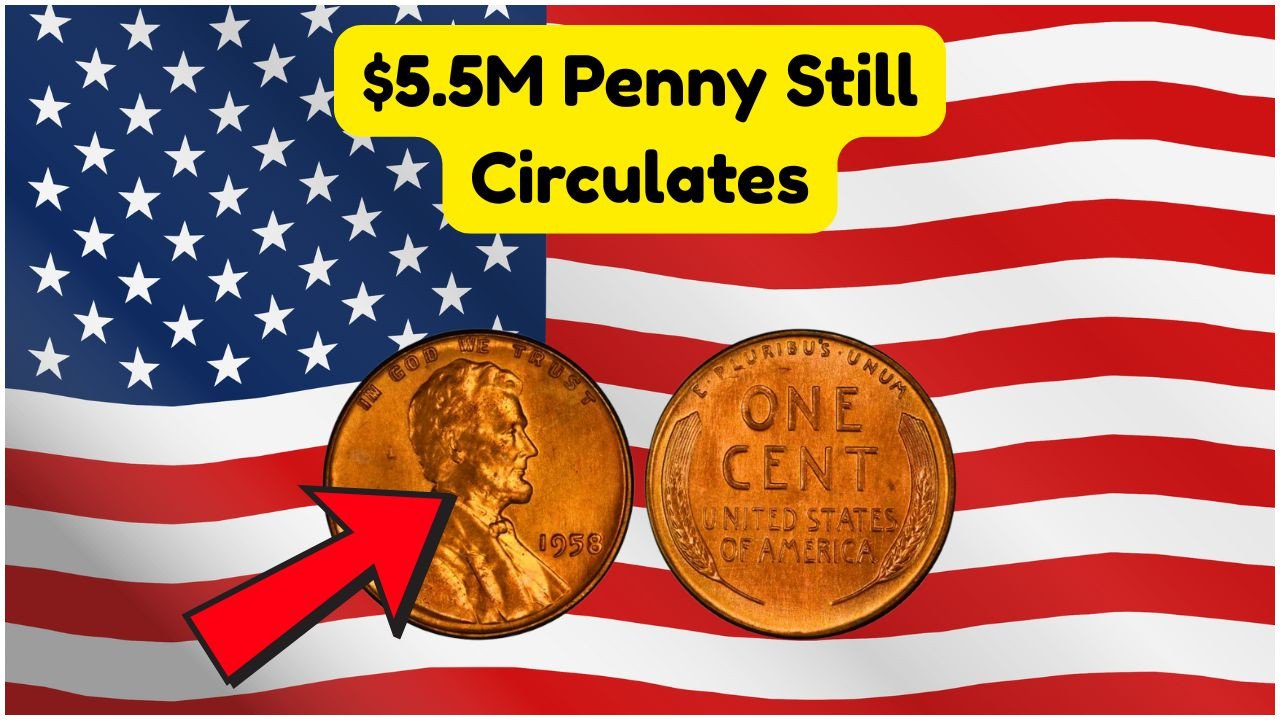Lincoln Wheat Penny Worth $5.5 Million
Table of Contents
Lincoln Wheat Penny Worth $5.5 Million: The world of numismatics is buzzing with excitement as news surfaces of an incredible discovery: a Lincoln Wheat Penny valued at an astonishing $5.5 million is still circulating among everyday coins. This remarkable coin has collectors and enthusiasts on a global scale wondering how such a valuable piece could remain unnoticed for so long. The Lincoln Wheat Penny, a staple of American coinage, has a storied history that dates back to its introduction in 1909, but this particular specimen has captured the imagination of many due to its rare and unique characteristics.
History of the Lincoln Wheat Penny
The Lincoln Wheat Penny was first minted in 1909 to commemorate the centennial of Abraham Lincoln’s birth. Designed by Victor D. Brenner, the penny features a profile of Lincoln on the obverse and two wheat stalks on the reverse, symbolizing prosperity. The coin was produced until 1958, becoming a beloved piece of American history. Over the years, certain editions have become highly sought after by collectors, with rare versions fetching thousands or even millions of dollars at auction. The 1943 copper penny, for example, is one of the most famous rarities, as most coins from that year were made from steel due to wartime metal shortages.
- Introduced in 1909 to honor Abraham Lincoln.
- Designed by sculptor Victor D. Brenner.
- Produced until 1958, featuring wheat stalks on reverse.
- Rare editions can be worth millions.
- The 1943 copper penny is a notable rarity.
The allure of the Lincoln Wheat Penny continues to captivate collectors. Its design, historical significance, and the potential for hidden treasures keep it at the forefront of numismatic circles. As more stories of rare finds emerge, the mystique surrounding these coins only grows, drawing in both seasoned collectors and curious newcomers eager to learn more about their history and value.

The Lincoln Wheat Penny Valued at $21 Million, Still in Circulation
What Makes a Penny Worth $5.5 Million?
Understanding what makes a Lincoln Wheat Penny worth $5.5 million involves delving into the intricate world of coin grading, rarity, and historical significance. Coins are evaluated based on their condition, rarity, and demand among collectors. The penny in question likely possesses a combination of these factors in exceptional measure. Rarity plays a crucial role; the fewer coins available, the higher the potential value. Historical anomalies, such as minting errors or unique metal compositions, can also significantly enhance a coin’s worth.
Key Factors Influencing Value:
- Condition and grading of the coin.
- Rarity due to limited mintage or errors.
- Historical significance and demand.
- Unique features like metal composition.
- Popularity among collectors and investors.
- Provenance and documented history.
The Journey of the $5.5 Million Penny
Tracing the journey of the Lincoln Wheat Penny worth $5.5 million reveals a fascinating tale of discovery and intrigue. How such a valuable coin remained in circulation for decades is a question that piques the interest of many. Stories of similar discoveries often involve coins being passed down through generations or forgotten in old collections, only to be rediscovered by astute treasure hunters or lucky individuals. The excitement of unearthing such a treasure is a dream for many coin enthusiasts, representing the possibility of finding a hidden gem in the most unexpected places.
How Was It Discovered?
- Discovered during a routine coin sorting.
- Initially overlooked due to its common appearance.
- Identified by an experienced numismatist.
- Confirmed through expert grading and verification.
- Gained attention through numismatic networks.
- Featured in prominent auctions and exhibitions.
Famous Lincoln Penny Finds
| Year | Description | Rarity | Estimated Value | Notable Features | Discovery Year | Current Location |
|---|---|---|---|---|---|---|
| 1943 | Copper Penny | Extremely Rare | $1.7 Million | Copper, instead of steel | 1980s | Private Collection |
| 1955 | Double Die | Rare | $125,000 | Double struck | 1960s | Various Collections |
| 1909 | V.D.B. Initials | Rare | $2,000 | Initials on reverse | 1910s | Museums |
| 1922 | No D Mint Mark | Rare | $20,000 | Mint mark missing | 1930s | Private Collectors |
| 1914 | D Mint Mark | Rare | $1,000 | Low mintage | 1920s | Coin Shows |
| 1944 | Steel Penny | Extremely Rare | $375,000 | Steel, instead of copper | 1990s | Auction Houses |
| 1931 | S Mint Mark | Scarce | $500 | San Francisco mint | 1940s | Collectors Worldwide |
Collecting Lincoln Wheat Pennies
For numismatists and hobbyists alike, collecting Lincoln Wheat Pennies is an exciting venture filled with the thrill of the hunt and the satisfaction of discovery. These coins offer a tangible connection to history and a glimpse into the economic past of the United States. Starting a collection can be as simple as examining pocket change or attending local coin shows and auctions. The diversity of the collection can vary widely, from focusing on specific years or mint marks to seeking out rare errors and variations.

The Lincoln Wheat Penny Valued at $100K, Still in Circulation
Building a comprehensive collection involves:
- Understanding the history and significance of each coin.
- Learning about mint marks and their locations.
- Recognizing rare error coins and their features.
- Networking with other collectors and experts.
Tips for New Collectors
Embracing the world of Lincoln Wheat Penny collecting requires a mix of patience, research, and sometimes a bit of luck. New collectors should start by familiarizing themselves with the basics of coin terminology and grading. Books and online resources can provide invaluable information on the different types of Lincoln Wheat Pennies and their respective values. Joining a numismatic society can also offer opportunities to learn from experienced collectors and gain access to exclusive events and auctions.
- Start with circulated coins to learn grading.
- Research key dates and rare varieties.
- Join a local or online coin club.
- Invest in quality storage solutions.
- Attend coin shows and auctions.
- Stay updated on market trends and prices.
Lincoln Penny Rarity and Value Table
| Mint Year | Mint Mark | Rarity | Condition | Value Range |
|---|---|---|---|---|
| 1909 | V.D.B. | Rare | EF-40 | $500 – $1,500 |
| 1914 | D | Rare | VF-20 | $200 – $1,100 |
| 1922 | No D | Very Rare | AU-50 | $5,000 – $20,000 |
| 1931 | S | Scarce | MS-65 | $60 – $275 |
| 1943 | Steel | Common | MS-63 | $0.30 – $10 |
| 1955 | Double Die | Rare | MS-60 | $1,000 – $2,500 |
| 1944 | Steel | Extremely Rare | MS-63 | $75,000 – $110,000 |
| 1958 | P | Common | MS-63 | $0.20 – $2 |
FAQ on Lincoln Wheat Pennies
What makes a Lincoln Wheat Penny valuable?
The value of a Lincoln Wheat Penny is determined by its rarity, condition, and demand among collectors. Coins with unique minting errors or historical significance often fetch higher prices.
How can I tell if my penny is a rare edition?
Look for key indicators such as mint marks, date, and any unusual features like double die errors or metal composition. Consulting with a numismatist can provide further insights.
Where can I sell my rare Lincoln Wheat Penny?
Rare pennies can be sold at coin shows, auctions, or through online platforms specializing in numismatics. It’s advisable to get a professional appraisal before selling.
Are all Lincoln Wheat Pennies collectible?
While all Lincoln Wheat Pennies hold historical value, not all are rare or highly collectible. Focus on those with unique features, low mintage, or specific mint marks to build a valuable collection.
What is the best way to store my coin collection?
Store your coins in a cool, dry place using acid-free folders or coin holders to prevent damage. Proper storage helps maintain the condition and value of your collection.
Disclaimer: This article is written for general informational purposes only. Please get the latest and accurate information from the official website.



